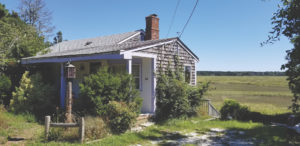EASTHAM — Usually, when a basement floods, the home owner starts planning to get rid of the water. When Joanna Buffington’s basement was inundated, she started planning to get rid of the house.
Now, nine years later, those plans are being realized, as Buffington helps usher her old Samoset Road home, now owned by the Eastham Conservation Foundation, through the final phases of being “unbuilt.”
“This was supposed to be when I’m dead,” mused Buffington last week.

In 1993, when Buffington purchased the house on 1.4 acres overlooking the marsh behind First Encounter Beach, she knew the basement tended to flood with the incoming tide. Built in 1960 as a duck hunting camp, the 1,008-square-foot ranch was not only in a wetland buffer zone; it was actually in the wetland.
“When it was built, they knew this,” said Buffington.
The original owners had installed the furnace and hot water heater on cinder blocks, and a caulked wooden “door dam” guarded the walkout basement entrance, hindering the encroaching tide but never completely preventing its trespass.
For the next 17 years, the house was rented out during summers and used by Buffington when she came to visit her parents, who lived nearby. In 2010, when she retired from her job as a medical officer with the Centers for Disease Control, Buffington moved to the house full-time.
The following year, a January nor’easter hit, with a one-two punch of high winds and tidal surge, pushing two feet of salt water into the basement and within inches of the raised furnace.
She decided then that the house should be removed and began to look for options that eventually led her to the Compact of Cape Cod Conservation Trusts and the Eastham Conservation Foundation (ECF).
“I knew that nobody should be living here,” said Buffington.
In 2012 she donated the property, at the time appraised at around $600,000, to the ECF, which she now serves as a trustee. She also established a life estate that would allow her to remain living there until her death.
“My family said, ‘What are you, crazy?’ ” said Buffington.
A confluence of factors, including increased flooding, prompted Buffington to give up the life estate in 2018 and move to higher ground. She turned the marshside site over to the ECF. “The signs were all coming together, so I said let’s go,” said Buffington.
The deconstruction project will be a first for ECF, which now owns about 300 acres. The foundation also administers 10 conservation restrictions. Buffington’s Samoset Road property is just its second instance of a donation involving structures, the other being a parcel on Goody Hallett Drive, where a youth hostel still operates under a long-term agreement.
ECF president Henry Lind said the Samoset Road property was accepted with the stipulation that the building and septic system be removed. In addition to the land donation, Buffington established a fund to pay the costs associated with the project.
The demolition and removal are expected to start later this year, after birds have fledged and plants have become dormant, so they can be removed and replanted later.
According to the project narrative submitted by Buffington, ECF volunteers will monitor the site to ensure planted and replanted vegetation is intact.
The conservation-minded protocols for the deconstruction stipulate that, where appropriate, materials are to be recycled or reused.
Already, the home’s solar panels have been moved to the Orleans Conservation Trust office (which shares space and staff with ECF), kitchen cabinets and counters have been relocated, and all but one window have been reused in another house.
“The proposed project to remove man-made structures, stabilize the bank, and allow migration of the salt marsh will help this section of the marsh to recover naturally,” states the project narrative.
ECF will monitor the property, watching for invasive species such as the Japanese knotweed that has already invaded in several properties.
As for future use of the property, Lind said some neighbors were concerned it would become a scenic park — which might draw traffic to the spot. He said the ECF had no plans for the property other than to “just leave it alone.”
The conservation commission is expected to hold a public hearing on the project sometime next month.
